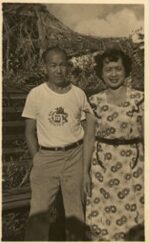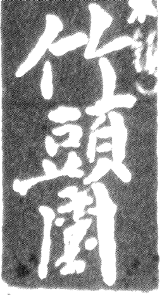Don’t Trust Everything You Read: the Importance of Verifying Source Material

Michael Ho
President of Chinese Family History Group 2018-2020
I have been researching my family history for over thirty years. This is absolutely true, but it does raise an interesting question:
Aren’t you done yet?
Let’s flashback to when I got started. I was interested in hearing family stories at an early age, and I might have asked about family members, but these actions don’t constitute family history research in itself. In the early 1990s, I was an undergraduate at the University of California, Irvine, and taking an introductory Asian American studies course taught by Professor John Liu. I was majoring in a technical field, so this class was elective. I was (and still am) a history buff, so this class certainly looked appealing.
The class had a term assignment: interview an older family member or create a family tree. It wasn’t convenient for me to interview family members like my surviving grandparents, so I opted for the family tree. Rather than just turning in a family tree diagram, I compiled a report that detailed the four family branches of my respective grandparents. I included copies of documents and photos (photocopied, because I didn’t have a scanner or laser printer back then). I proudly received an ‘A’ grade for that report. And you know what? While most of my report was correct, I got some things totally wrong.
In the following years, I learned more about genealogy, Chinese American history, immigration, the Chinese case files at the National Archives, and much more. Technology has made more information accessible. The more that you know, the more that you can discover. Had I had stopped researching my family history after that classroom assignment, I wouldn’t have told the full or fully-correct story.
In general, people tend to trust printed or published works. The idiom “wrote the book on” often refers to someone who is an expert on a particular subject. Traditionally, it was widely accepted that people who wrote books and got them published were most likely experts. Printed content was assumed to be peer-reviewed, fact-checked, fully-vetted, et cetera. However, when you find a published or printed resource for your family’s history, you should review the contents for veracity. For example, if you attend a family reunion, there’s a good chance that someone has prepared and shared a family tree. These are definitely great resources, but by all means, check out the contents and try to verify. People make mistakes.
Here’s another example: not long after I earned that ‘A’ on the paper, my grandfather passed away. After the funeral in Honolulu, someone with the Ho surname approached me. He heard that I was interested in genealogy, and he told me that he had a book that explained the entire Ho family genealogy. I didn’t connect with him again during that trip and later wasn’t able to get a copy of the book. I proceeded with my research and made my first visit to my Ho family’s ancestral village in China in 1996. I was the first in my immediate family to visit there since 1930. The ancestral home was gone, but the ancestral plaque with my great-grandfather’s name survived. In 2000, I took my dad to visit the village, and I made a more recent visit in 2019.

Years after my first visit, I learned that the aforementioned book was titled Genealogy of the Ho family, 892 A.D.-1982 A.D., which had been compiled by members of the Ho Society of Hawaii, a family association based in Honolulu.

My grandfather served as president of the Ho Society of Hawaii during the 1950s. Because he worked as a commercial artist, I think that it’s highly likely that he designed the group’s logo at the time, which appears on a T-shirt that he wore in a family photo.
When I got a chance to take a look at the genealogy book, I discovered that my family was not included. Why not? By the time that the book was being compiled, my grandfather was no longer an active member in the group. Either the group did not reach out beyond their active membership, or my grandfather chose not to participate. Still, I wanted to see if the book could help fill in some missing information from my family tree. Apparently, the Ho Society of Hawaii’s members in the mid- to late-1970s were asked to complete family group sheets. The project then sought to connect these members’ family trees with an extensive genealogy previously compiled for a prominent member’s family. The latter tracked his family history to 892 A.D.
Sounds great! Right?
There were two primary assumptions made by the book’s compilers: (1) all of the participating Ho families shared the same ancestral village with the prominent member (they didn’t), and (2) the prominent member’s genealogy was 100% correct (it wasn’t). Looking at the book, there is a glaring absence of Chinese characters for individual’s names and place names. It appears that the participating members’ families might have been linked to the prominent member’s family tree by matching up Romanized names rather than names using Chinese characters. This is problematic with homophones in the Chinese language. It’s possible that Chinese names were matched with Chinese names before they were Romanized, but it’s impossible to tell from what was printed in the book. Putting that aside, the book appears to link all of the participating families to a village in Zhongshan called Chu T’ou Wei. This was a Wade Giles Romanization, and the Pinyin spelling would be Zhu Tou Wei. But my ancestral village’s name (and that of many, but not all, Ho families in Hawaii) is Zhu Tou Yuan.
I found the source material of the prominent member’s genealogy and found a possible explanation. The original Chinese text shows the village name as:

The first two characters are clear: Zhu 竹 (meaning “bamboo) and Tou 頭 (“head”).
The third character is unclear, so I surmise that the translator decided that it was the character Wei 圍. Thus, he spelled the village name as Chu T’ou Wei (Pinyin: Zhu Tou Wei).
But the character should have been Yuan 園, meaning “garden.” The correct village name is Zhu Tou Yuan 竹頭園 (or Chu T’ou Yüan using Wade Giles).
(reference: https://villagedb.friendsofroots.org/display.cgi/village/6913)
The translator made a judgment call on which character to use, just as someone reading a handwritten record in English might need to choose between the letters ‘f’ or ‘t’ in a document. You can’t blame the translator, especially if additional background or context wasn’t provided. But had the prominent member or his family checked with Ho family “old-timers” in Hawaii, they could have corrected the error. Similarly, if the Ho Society book compilers had done the same, the error could have been caught. And even if the “old-timers” were not around (they were—I corresponded with and visited one in the early 1990s), the correct Chinese characters of the village name were etched on a number of gravestones in Honolulu cemeteries.
Back to my original point: published works are great reference tools, but you should try to verify details wherever possible. We want to share our family histories with others. It’s a good idea to include a date or version number with any history or summary that you share. That way, your family members will know if they are reading the latest and greatest version. The compiler of Genealogy of the Ho family, 892 A.D.-1982 A.D. indicated that it was a first edition, so perhaps it was intended to have further editions. However, the Ho Society of Hawaii did not survive. I’m still searching for sources to fill in gaps in my Ho family history. Even for parts of my family history that are more complete, I want to clarify more details. And for brick walls, the information may be out there, just waiting to be discovered.
Am I done yet? No, not yet.

Hi, my name is Pamela Ho. I just read you story above and was intrigue. I am trying to my family history too. Would we be able to connect?